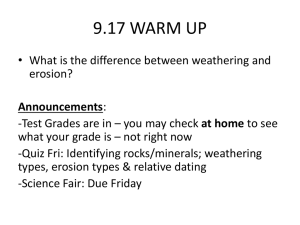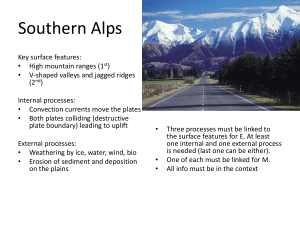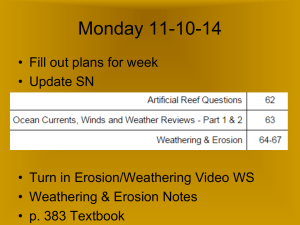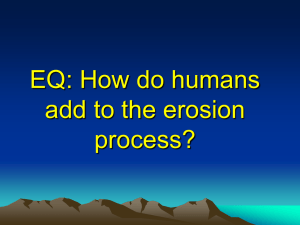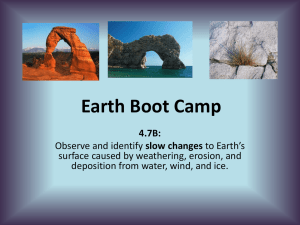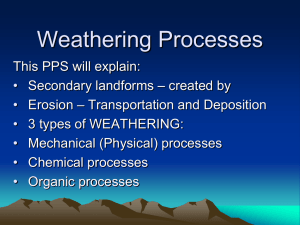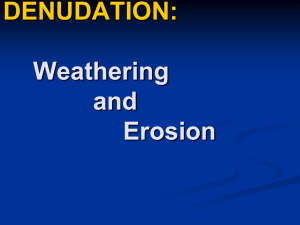Chapters 7-9 - Ms. Banjavcic`s Science
advertisement
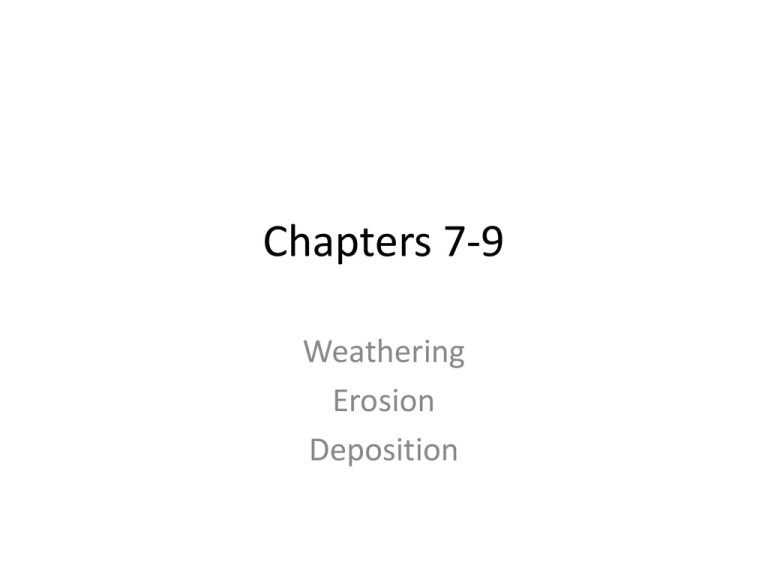
Chapters 7-9 Weathering Erosion Deposition Chapter 7: Weathering and Soil • Weathering: surface processes that work to break down rock – Weathering breaks rock into smaller and smaller pieces (sediment) such as sand, silt and clay (these terms are used to describe the sizes of the particles). Sand grains are larger than silt and silt is larger than clay. – Over millions of years, weathering has changed Earth’s surfaces and this process continues today • Two types of weathering: • 1) Mechanical weathering • 2) Chemical weathering 1) Mechanical weathering: breaks apart rocks without changing their chemical composition (without changing the type of rock) – IE – growing plants, burrowing animals, expanding ice, mineral crystal growth, lightning and expansion and contraction due to heat or cold • These processes produce enough force to break apart rocks • More surface area is then produced for additional weathering (pg. 184) • Usually occurs in cold climates…freezing… 2) Chemical weathering: the reaction of water, air, and other substances with the minerals in rocks which changes the chemical composition of the rocks – water (H & O) react with rocks – acids – CO from air mixes with water and forms carbonic acid (Soft drinks…) – Carbonic acid dissolves minerals in limestone…this can form caves… – Acids from plants and rotting plants can dissolve minerals in rocks also…this weakens and then will cause the rocks to break… – Oxidation: Oxygen combined with water…. causes iron to rust…rocks that contain iron then turn reddish in color… – Usually occurs in warm, wet climates… – Dry climates slow down chemical weathering…IE…? Weathering’s Effect on Climate • Climate: pattern of weather that occurs in a particular area over many years • Climate affects soil temperature and moisture and also affects the rate of mechanical and chemical weathering. • In cold climates, where freezing and thawing are frequent, mechanical and chemical weathering rapidly breaks down rock through the process of ice wedging. • Chemical weathering is more rapid in warm, wet climates. • High temperatures tend to increase the rate of chemical reactions. • Chemical weathering tends to occur quickly in tropical areas. • Lack of moisture in deserts and low temperatures in polar regions slow down chemical weathering. Soil Erosion • Soil erodes when it moves from the place where it originally forms. • Erosion occurs as water flows over Earth’s surface or when wind picks up and transports sediment. • More severe on steep slopes or where there is little vegetation. • Under normal conditions, a balance between soil production and soil erosion often is maintained = soil forms at about the same rate as it erodes. • Humans sometimes cause erosion to occur faster than new soil can form. • Agriculture cultivation: nutrients taken from topsoil, quality of soil reduced so extra fertilizers need to be added. • Forest Harvesting: when trees are cut down, soil is exposed and erosion increases. • Overgrazing: in some areas of the world, sheep and cattle graze on grasses until almost no ground cover is left to protect the soil. • Excess Sediment: could be deposited into streams which could fill up. Preventing Soil Erosion • Manage Crops • No-till Farming: farmers leave plant stalks in the field over the winter months. At the next planting they seed crops without destroying these stalks and plowing the soil. •Provides cover for the soil year round which reduces water runoff and soil erosion. • Reduce Erosion on Slopes • Contour Farming: planting along the natural contours of the land…slows water down the slopes. Flatten the soil in your plate. Find 3 ways to move the soil from one side of the plate to the other. You may not touch the soil with your hands! But, you can touch the plate. Do not spill! 12/13/10 Erosion: process that wears away surface material and moves them from one place to another • major causes: gravity, glaciers, wind, water • they all need energy for motion! Deposition: the dropping of sediments that occur when an agent of erosion looses its energy of motion and is no longer able to carry the load • drop when energy of motion decreases! What causes erosion and deposition? - Gravity! What is gravity? The force of attraction that exists between all objects - Since Earth is so large, all objects are attracted to it. - The Earth is the source of all our gravity. - Any loose material will be pulled down a slope (hill), due to gravity. - When gravity alone causes material to slide down a slope this is called mass movement. 12/13/10 Examples of mass movement: 1) Slump: mass movement that happens when loose rock layers slip down a slope. • When a slope becomes too steep, the base material no longer can support the rock and sediment above it. • The soil and rock slip downslope as one large mass or break into several sections. 2) Creep: sediments slowly inch their way down a hill…most common in freezing areas. • Ex: Leaning trees and fence posts that lean downhill. 12/13/10 3) 12/13/10 Rockfalls (tumble) and Rock Slides: when large rocks break loose and tumble down a hill…can be very destructive! • Rockfalls - As rocks fall and tumble through the air, they crash into other rocks and knock them loose. More and more rocks break loose and tumble to the bottom. • Rock Slides – occur when layers of rocks – usually steep layers – slip down a slope suddenly. Happen most after heavy rain or earthquakes. 4) Mudflows: a thick mixture of sediment and water flowing down a slope…dry areas with thick layers of sediment that suddenly get really wet from rain… All mass movements… • • • Occur on slopes… Occur more often after a rain… Increase if vegetation has been removed… How can you prevent these problems? • Strengthen slopes with vegetation…roots hold soil together • Walls made of concrete… We can try all we want to avoid erosion and deposition problems, but in the long run…gravity will still be too powerful! IE – video of mudslide… 12/13/10 Erosion by Glaciers! • Glacier – a large mass of ice and snow moving on land under its own weight. • As glaciers pass over land, they erode it, changing features on the surface. • They then carry eroded material along and deposit it somewhere else. • Change large areas of the earth’s surface. Plucking – process that adds gravel, sand and boulders to a glacier’s bottom and sides as water freezes and thaws, breaking off pieces of surrounding rock. • 12/13/10 Transporting and Scouring – as glaciers move forward over land, they can transport huge volumes of sediment and rock. The rock leaves marks behind as it moves. • Plucked rock fragments and sand at its base scour and scrape the soil and bedrock like sandpaper against wood, eroding the ground below even more. • When bedrock is gouged deeply by rock fragments being dragged along, marks are left behind. • Deep, long parallel scars are called grooves. • Shallow marks are called striations. • These indicate the direction in which the glacier moved. • 12/13/10 Ice Depositing Sediment… When glaciers begin to melt, they are unable to carry much sediment and that sediment drops, or is deposited, on the land. • When a glacier melts and begins to shrink back, it is said to retreat. • As it retreats, a jumble of boulders, sand, clay and silt is left behind. • The mixture of different sized sediments is called till. • Till deposits can cover huge areas of land. • Thousands of years ago, huge ice sheets in the northern US left enough till behind to fill valleys completely and make these areas appear flat. • Ex: areas of Montana, Iowa, Ohio, Illinois, Indiana and New England. • 12/13/10 Moraine Deposits – large ridges of rocks and soil deposited by a glacier when it stops moving forward. • Outwash Deposits – material deposited by meltwater from a glacier. • Eskers – a winding ridge of sand and gravel left behind when a glacier melts. • Pg. 217 • 12/13/10 Wind! Wind erosion: air moves and picks up particles and deposits them in other places • Air differs from other erosional forces because it can’t normally pick up heavy objects, but it can deposit sediment over a large area • Wind erodes Earth’s surface by deflation and abrasion… • Deflation: wind blows across loose sediment and removes small particles and leaves behind heavy material…big rocks… • Abrasion: windblown sediment hit rocks and surface gets worn away – occurs everywhere…but mostly in deserts, beaches & plowed fields • WHY? – fewer plants to hold sediment • Sandstorms - sand is normally too heavy for wind…wind blows forcefully & sand bounces & hits other grains causing them to rise into air (low cloud just above ground…) • Dust storms - dry soil picked up by wind and blown high into atmosphere because they weigh less than sand…carries particles far distances… • • 12/13/10 • IE – 1930…dust picked up in Kansas was found in New England… important part of soil erosion… Reduce wind Erosion: • Erosion is most common in areas with no plants… • Stop erosion?…PLANTS! • Vegetation will reduce erosion… • Roots hold soil in place • Windbreaks with trees – slow down wind… • Stop energy of motion… • IE – row of cottonwood trees reduced wind to 66% of normal speed But…strong wind with dry soil…nothing will stop erosion by wind! 12/13/10 Deposition by wind: sediments are eventually deposited in new areas… Creates a variety of land forms… Loess: wind deposits of fine- grained sediment…packed together creates a thick unlayered yellowed- brown colored deposit What happens when wind blows sediment against an obstacle? = dune! Dunes: created when sediment settles behind an obstacle Dunes can be moved as sand is lifted and deposited downwind…(picture ) Overall…Erosion and Deposition constantly shape and reshape the land! 12/13/10 Chapter 9: Water Erosion Surface Water Runoff – water that doesn't soak into the ground or evaporate but instead flows across Earth's surface. Factors affecting runoff: Amount of rain Length of time rain falls Ex: light rain falling over several hours will have time to soak into the ground while heavy rain falling within an hour will run off because it cannot soak in fast enough. Steepness of slope Vegetation Water Erosion Rill erosion – begins when a small stream forms during a heavy rain. Water moving down the same path creates a groove called a channel. Gully erosion – when a rill channel becomes broader and deeper. Sheet erosion – when water erodes without being in a channel. This occurs when water that is flowing in sheets picks up and carries away sediments. Ex: how water flows off the hood of a car. Stream erosion – takes place when water continues to flow along a low place it has formed. As water moves along it picks up sediments from the bottom and sides of the channel...this process makes the stream deeper and wider. Too Much Water FLOODS!!!! Water needs to go somewhere when there's too much of it. Dams and levees are built in an attempt to prevent flooding. Deposition of Surface Water Some stream sediment is carried only a short distance...sediment is often deposited within the stream channel itself. Deltas – sediment that is deposited as water empties into an ocean or lake that forms a triangular, or fan-shaped deposit. Alluvial fan – when the river waters empty into a mountain valley onto an open plain. Create a Study Guide! Using key terms and main ideas from chapters 7, 8 and 9 create a study guide AND answer key (on separate sheets of paper). 10 fill in the blank questions 5 multiple choice questions 5 true or false questions Ex: ______ is a mixture of weathered rock, organic matter, mineral fragments, water and air. 12/13/10 REVIEW!! • Fold a piece of computer paper in quarters. • Using both the front and back, complete one bullet pointed topic in each box. • Add some color! • Keep this! You get to use it on the quiz! • Illustrate a slump. Include a caption. • Illustrate a creep. Include a caption. • Illustrate a rockfall/rockslide. Include a caption. • Illustrate agriculture cultivation. Include a caption. • Create a Venn Diagram comparing mechanical and chemical weathering. Include examples for each. • List and define the 4 types of water erosion. • List 6 ways to prevent all kinds of erosion. • Illustrate deflation vs. abrasion (so divide your last box into two)

